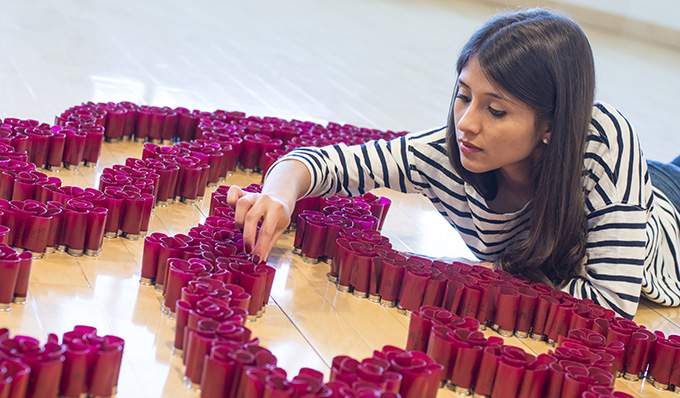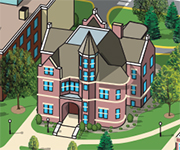Bullets to Beauty
Graduating senior transforms spent ammunition into healing art
BY ANITA CIRULIS
PHOTOS BY DOUG BURG

Norma Gonzalez arrived home in Pitalito, Colombia, accompanied by two strangers. She placed her 11-month-old daughter in the arms of her younger sister and told the 16-year-old to take the baby inside and stay there. When the girl asked who the men were, Norma assured her everything was fine.
Moments later, the teenager emerged from the house just in time to see Norma crying as she was driven away on a motorcycle. That was the last time the young mother was seen alive. Two days later, her body was discovered in a rural area 21 kilometers from Pitalito.
The infant whose life was spared has no memory of the mother who was murdered just weeks before the little girl's first birthday. Claudia Bomgaars-Soto '15 knew that her mother had been killed, but nothing else. "Growing up, it was just painful," she recalls. "I need to know, but I don't want to ask. Even mentioning my mom's name to my dad, it was just really bad for him."

All that changed this spring when her mother's death became the focus of Bomgaars-Soto's senior art exhibit. Her husband, Curtis Bomgaars '10, an avid hunter, brought her used shotgun shells and bullet casings and suggested she use them for her art.
"I found them kind of beautiful because they were gold and silver—simple—and together they looked really nice," she says, "but for me it's just something that causes a lot of damage."
Bomgaars-Soto witnessed that damage firsthand growing up in Colombia. For more than 50 years, the country's drug cartels and guerilla groups have created a culture of intimidation and fear. As a child she saw bullet-riddled bodies when attending the funerals of extended family members and friends. Even today, farmers and retailers in the region must pay protection money, called vacuna—Spanish for vaccination—to be able to work and remain safe.
For Bomgaars-Soto, her art exhibit was both therapy and testament. She used kitchen shears to cut blood-red shotgun shells so they took on the appearance of roses. A hammock suspended from the ceiling was made of brass bullet casings strung on rope and fishing line. Spent ammunition glued to a mirror allowed people to see their reflection as they viewed the art piece.
"I grew up not talking about what happened," Bomgaars-Soto says, "so I thought it was maybe a chance to use it, to process it. I never thought about letting other people know [about my mother's murder] because it's just something you don't imagine." As she transformed symbols of violence into things of beauty, she was changed as well. "I was able to feel like I could speak about [it] because I wasn't really doing the work. My artwork was already opening that path to talking about different things."

Through conversations with family members, including a sister who was 9 at the time of the murder, Bomgaars-Soto was able to put the pieces of her life story together. She learned that, most likely, someone jealous of her parents' successful, growing meat market business hired the guerilla group FARC to eliminate the competition. That her mother—smart, organized and detail-oriented—was "the mind of the business." That afterward, her father was advised by the police to leave town for his own safety. That his departure is the reason she and her sister grew up with different relatives. That her father tried to find out who was behind his wife's murder, but he was only able to discover that FARC did it.
Norma Gonzalez was 23 when she was killed—just a year older than her daughter was during her April exhibit. A painting by Bomgaars-Soto that was part of her art show portrays Gonzalez in her wedding dress, but aged as she might appear today. The young artist titled it "Growing Together" because, "I'm getting to know her. I didn't know she had this little scar here or when she smiles the little dimples. It was just fun to see her and paint her and have that time together."
By sharing her past with others, Bomgaars-Soto wants people to know God is faithful in the midst of pain and sorrow. He is able, she says, to transform one's story, making beauty out of brokenness, much like—in the hands of a young woman acquainted with grief—bullets can become art. 
 Graduating senior transforms spent ammunition into healing art.
Graduating senior transforms spent ammunition into healing art. Before you return to your alma mater, discover something new about Northwestern.
Before you return to your alma mater, discover something new about Northwestern. Northwestern alum joins trend of living simply in a small space.
Northwestern alum joins trend of living simply in a small space. An interview with Jordan Plummer '09.
An interview with Jordan Plummer '09.
Classic Comments
All comments are moderated and need approval from the moderator before they are posted. Comments that include profanity, or personal attacks, or antisocial behavior such as "spamming" or other inappropriate comments or material will be removed from the site. We will take steps to block users who violate any of our terms of use. You are fully responsible for the content that you post. Comments posted do not reflect the views or values of Northwestern College.